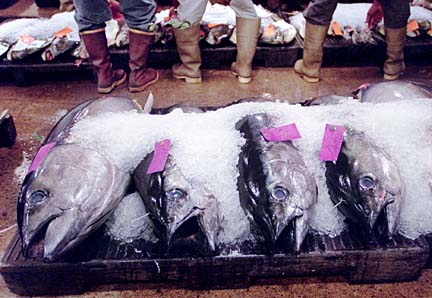Advertisement - Click to support our sponsors.


Longliners Fisherman Gene Kohler is worried about a National Marine Fisheries Service draft recommendation to close all fishing by Hawaii-based longlining vessels two months of every year.
hope to scuttle
fishery closures
'What's the point of closing
our fishing and letting those boats
from other countries fish here?'By Rosemarie Bernardo
Star-Bulletin
"If you don't catch fish, you don't make money. How are we supposed to support our families?" said Kohler, 30, who has a 12-year-old son, Richard, and a 6-year-old daughter, Colleen.
"They have to find a way where it's fair for everybody. They're shutting us out."
The two-month closure recommendation is part of a draft environmental impact statement on the effect of longliners on endangered sea turtles that sometimes get hurt or killed in their lines.
U.S. District Judge David Ezra ordered the EIS as part of a lawsuit filed by the Turtle Island Restoration Network and the Center for Marine Conservation. The environmental groups allege that the fisheries service failed in its duty to protect endangered turtles.
Temporary restrictions on longline fishing enacted by Ezra are in effect until the environmental impact statement is complete. Since August the judge has effectively closed longlining for swordfish, and since November required observers be aboard 20 percent of tuna longlining boats.
Public hearings on the draft begin Jan. 3 on Maui and will be held on each of the Hawaiian Islands. A final copy of the study is due to the judge in April.
Meeting times and places are on the Net at swr.nmfs.noaa.gov.
A second key proposal in the draft is that fishermen use devices such as line-shooters that put fishing lines at greater depths. Deeper lines are believed to have a lesser likelihood of snagging or killing sea turtles.
"In the two years that I've been fishing, I've never caught a sea turtle," Kohler said. "What's the point of closing our fishing and letting those boats from other countries fish here?"
Sean Martin, president of the Hawaii Longline Association, said longliners have already been operating on the deep-set requirement since early November.
But a two-months-a-year closure, he said, would "do irreparable harm to the seafood industry in Hawaii."
Martin said he and other longline fishermen plan to provide input regarding the draft at the public meetings.
As Sue Myking, the wife of a longline fisherman, put it: "I just think it's a shame to give up our fisheries and give it to foreigners when we may (then) import the fish from those countries that fish the same waters that we're banned from."
The Hawaii Longline Association plans a workshop Jan. 9-11 in San Diego targeting an international effort to reduce interactions between sea turtles and longliners.
Kahu Charles Kauluwehi Maxwell, a former member of the Western Pacific Regional Fishery Management Council, said he believes the draft proposal is a positive move in balancing the ecosystem.
"Mankind has tapped the resources to almost extinction," said Maxwell, 63. Extreme measures need to be taken to bring back the fish stock, he said.
Issac Harp, a former board member of the Western Pacific Regional Fishery Management Council, put it another way.
"The fishery of today is too efficient," he said. "Within the next 50 years, we're going to be eating aquaculture-raised fish."
Special section: Caught in controversy Longline ban ruling
Longline ban in effect
NOAA Fisheries headquarters